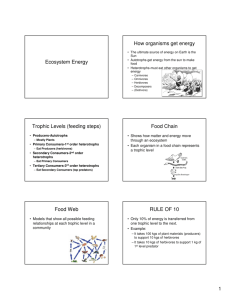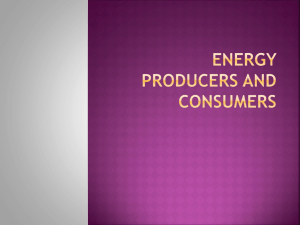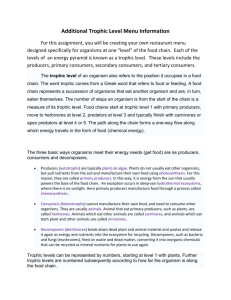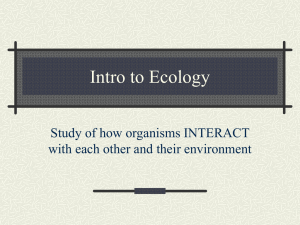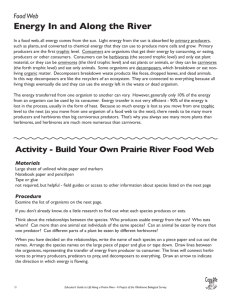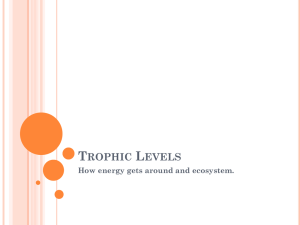food chain - Collinswood7thGradeScience
advertisement
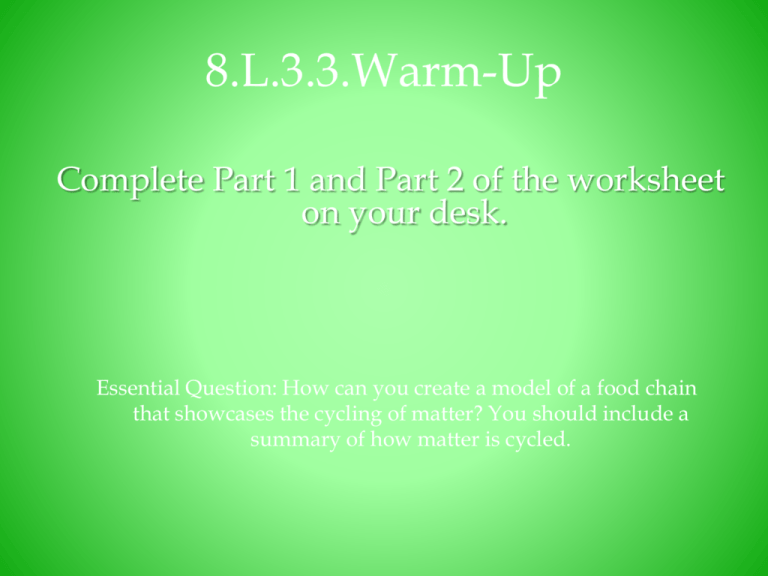
8.L.3.3.Warm-Up Complete Part 1 and Part 2 of the worksheet on your desk. Essential Question: How can you create a model of a food chain that showcases the cycling of matter? You should include a summary of how matter is cycled. Activity Who’s For Dinner: Build a food chain of Antarctic organisms and discover how the chain makes up part of a more complex food web. http://app.discoveryeducation.com/search?Ntt=flow+of+energy+in+ecosystems#selIte msPerPage=20&intCurrentPage=0&No=0&N=18342%252B4294938914&Ne=&Ntt=fl ow%252Bof%252Benergy%252Bin%252Becosystems&Ns=&Nr=&browseFilter=&ind exVersion=&Ntk=All&Ntx=mode%252Bmatchallpartial 8.L.3.3. Food Chain • A series of organisms that shows that each one eats the organism of the lower level. • The arrows point in the direction of the flow of energy. Food Chain: Producers 1st trophic level: Also called autotrophs Use Sun’s energy to combine CO2 and water to produce glucose and oxygen Releases oxygen and gains food through photosynthesis Food Chain: Consumers Animals that can’t make their own food Get food by eating other organisms Also called heterotrophs An animal that feeds directly off of producers is a first-order consumer 10% of the energy in one trophic level is passed to the next Food Chain: Herbivores 2nd trophic level: Eat producers. Use food for energy and other functions Most of consumed energy is lost as heat Include grasshoppers, deer, and rabbits Food Chain: Carnivores 3rd trophic level: Eat producers and herbivores Use food energy things necessary for their function Include humans, wolves, hawks, bears Food Chain: Decomposers Break down organic matter Return organic matter (nitrogen and carbon) to environment and make the nutrients available to other animals Include mushrooms, worms, bacteria, cockroaches Producer Herbivore 1-order consumer Carnivore 2-order consumer Carnivore 3-order consumer Carnivore Decomposer Roles of the trophic levels • As different organisms use the energy in an ecosystem, matter is being cycled. • When producers use CO2 and make oxygen, they cycle matter. • When herbivores and carnivores eat and use their food for their bodies and breath oxygen, they cycle matter. • When decomposers break down this material, they cycle matter back into the soil for producers. Food Web A food web is made up of many connected food chains that show the flow of energy in ecosystems. • Energy goes through various chemical reactions in a food web. • Transfers of matter happen in each trophic level. • When molecules from food react with oxygen, the carbon dioxide and water are transferred back to the environment. • Decomposers play their part by recycling dead plant and animal matter back into the soil or in the water. • Energy in the environment is transferred in the cycle between biotic and abiotic factors. • http://app.discoveryeducation.com/search?Nt t=flow+of+energy+in+ecosystems#selItemsPer Page=20&intCurrentPage=0&No=0&N=18342 &Ne=18339&Ntt=flow%2Bof%2Benergy%2Bin %2Becosystems&Ns=&Nr=&browseFilter=&in dexVersion=&Ntk=All&Ntx=mode%252Bmatch allpartial Practice You will be filling in the food web. In the food web you should write the trophic level, what type of organisms are in that trophic level (herbivores, carnivores, etc.), and a brief description of how they aid in cycling matter. Practice Answer the questions on the Energy Flow worksheet independently. You can use your notes if necessary. Assessment Without using your notes, complete the fill in the blank paragraph with your new knowledge and answer the question. This is not group work: work independently!

